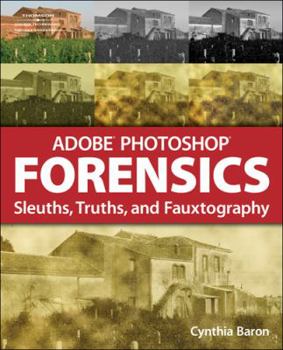Adobe Photoshop Forensics
Select Format
Select Condition 
Book Overview
Shows you how Photoshop is used to create many types of fakery and fraud, including scientific, counterfeiting, art, journalism, and political propaganda. This guide lets you discover that with some... This description may be from another edition of this product.
Format:Paperback
Language:English
ISBN:1598634054
ISBN13:9781598634051
Release Date:October 2007
Publisher:Course Technology
Length:364 Pages
Weight:2.25 lbs.
Dimensions:0.9" x 7.4" x 9.1"
Customer Reviews
4 ratings
Fun read, bot not meaty
Published by Thriftbooks.com User , 16 years ago
"Adobe Photoshop Forensics" is billed as a guide to forensic examination images for manipulation, and subtly implies that you, too, can become a forensic investigator by studying this book . . . Not so much . . . It is, however, a fun read, and a backwards introduction on how to do effective, convincing image manipulation. I blew through it in about 24 hours, and I'm not asking for the time I spent on it back. "Adobe Photoshop Forensics" is divided into four parts: "Counterfeiting and the Law," covers not just counterfeiting of cash, but also counterfeit IDs, photos used for insurance documentation or court cases, and other legal-ish or money-ish issues. "Professional Misconduct" covers propaganda and political images, photojournalism and editorial shenanigans, and science-related images. "Body of Evidence" relates primarily to image manipulation related to the human body, with a small foray into compositing and composite images. "Outer Limits" scoops up more fringe-ey fun with topics like faking UFOs, ghosts, and urban legends. Each of the four part is divided into chapters and sections, with each section having at least one sample image that is analyzed, and/or manipulated step-by-step. I'm Photoshop-challenged and so only skimmed the tutorials, but they appeared straightforward. However, it also appears that this would not be a good book to actually learn image manipulation in any kind of detail from - these are more examples of one way (the simplest?) that the desired results can be achieved. Related to that, some of the sample images aren't large enough to really show the effects of the steps they are supposed to illustrate. The publisher's web page for the book has links for errata and other information, in zip files. It appears that the author shared this complaint, I see several comments in the errata that the pictures are too small. In fact, the errata is not so much errata, as a copy of the author's comments to the publisher. The second download does contain some images that help, but not two that are completely missing from the text (referred to in the text and skipped over in the illustration numbering). Sloppy editing, particularly in a book all about image manipulation. Not all of the manipulated images shown are actually results of digital manipulation, as the author fits "photoshopping" in the overall historical context of image manipulation, and discusses how Photoshop has made certain tasks easier, and how today's ease of image manipulations affects (or should affect) our perception of images used in advertising, etc. All in all, an amusing introduction to image manipulation.
Enjoyable overview of the topic
Published by Thriftbooks.com User , 17 years ago
This book is an enjoyable treatment of this topic for the general reader. When reading it from that perspective, it provides a great overview of what any of us might see in our day-to-day lives - altered political photos, actresses on the Photoshop Diet Plan, falsified documents on the internet, etc. Seeing the examples in Baron's book can make us a little more aware and a little more skeptical of what we see in advertisements, newspapers, magazines, and the internet. This book is not, however, a technical book for the forensics professional - nor does it claim to be. As an expert in imaging forensics, I was careful when reading this book to not judge it from the wrong perspective - this book isn't intended to be a reference for those in my field. But, it still is an enjoyable read with some good information. I didn't care for some of the anecdotal treatments, and I disagreed with some of the content - but since it was written for a broader audience, those became minor points. If this were a technical text, these would have been more important issues. Does the book belong on the shelf of every forensic image analyst? Probably not - but it will be enjoyed by anyone who is curious about this field, or who wants to be a bit more savvy regarding the photos and documents we are confronted with every day.
Very enjoyable, great for all Photoshop users
Published by Thriftbooks.com User , 17 years ago
This was a fun read: a very interesting blend of historical (such as forensics on Civil War era images) and/or real life situations (such as counterfeit money) blended with a compendium of Photoshop tricks and tips. I use Photoshop frequently for work and in college classes, and as always I'm amazed at how many features are packed into the program. The author is able to bring many of these features to bear in clearly worded, step-by-step examples (such as modifing the a model's image to remove blemishes and punch up the photo's visual qualities for a magazine cover). The book will appeal to multiple levels of Photoshop users, from beginner to advanced, and will also go down well with anyone with an interest in history. Nicely done.
Good book
Published by Thriftbooks.com User , 17 years ago
I am enjoying this book very much. It makes for a really good read. However, if the files for the book had been included or down loadable, it would definitely been 5 stars.






